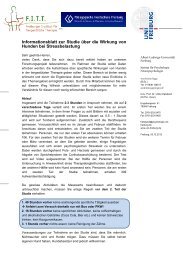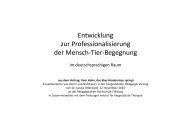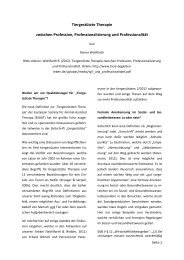Tiergestützte Therapie: Die geschichtliche Entwicklung - Freiburger ...
Tiergestützte Therapie: Die geschichtliche Entwicklung - Freiburger ...
Tiergestützte Therapie: Die geschichtliche Entwicklung - Freiburger ...
Sie wollen auch ein ePaper? Erhöhen Sie die Reichweite Ihrer Titel.
YUMPU macht aus Druck-PDFs automatisch weboptimierte ePaper, die Google liebt.
<strong>Tiergestützte</strong> <strong>Therapie</strong>: <strong>Die</strong> <strong>geschichtliche</strong> <strong>Entwicklung</strong><br />
dom of choice, personal space, appropriate<br />
allocation of programme resources, appro-<br />
priate workload clearly defined roles, con-<br />
fidentiality, communication systems and<br />
training provision for all persons involved.<br />
The IAHAIO Rio Declaration 2001 on<br />
Pets in Schools<br />
Given the strong evidence that has accumu-<br />
lated in recent years demonstrating the value,<br />
to children and juveniles, of social relation-<br />
ships with companion animals it is important<br />
that children be taught proper and safe be-<br />
haviour towards those animals and the correct<br />
care, handling and treatment of the various<br />
companion animal species.<br />
Realising that companion animals in school<br />
curricula encourage the moral, spiritual and<br />
personal development of each child, bring so-<br />
cial benefits to the school community and en-<br />
hance opportunities for learning in many dif-<br />
ferent areas of the school curriculum, IAHAIO<br />
members have adopted fundamental guide-<br />
lines on pets in schools at their General As-<br />
sembly, held in Rio de Janeiro in September<br />
2001.<br />
IAHAIO urges all school authorities and teach-<br />
ers, as well as all persons and organisations<br />
involved in pet programmes for schools, to<br />
consider and abide by the following guide-<br />
lines:<br />
1. Programmes about companion animals<br />
should, at some point, allow personal con-<br />
tact with such animals in the classroom<br />
setting. Depending on school regulations<br />
and facilities, these animals will:<br />
© <strong>Freiburger</strong> Institut für tiergestützte <strong>Therapie</strong><br />
a) be kept, under suitable conditions, on<br />
the premises, or<br />
b) be brought to school by the teacher, or<br />
c) come to visit, in the context of a visiting<br />
programme, together with their own-<br />
ers, or<br />
d) accompany, as a service dog, a child with<br />
special needs.<br />
2. Any programme involving personal contact<br />
between children and companion animals<br />
must ensure:<br />
a) that the animals involved are<br />
- safe (specially selected and/or<br />
trained),<br />
- healthy (as attested by a veterinarian),<br />
- prepared for the school environment<br />
(e.g. socialized to children, adjusted<br />
to travel in the case of visiting ani-<br />
mals),<br />
- properly housed (either in the class-<br />
room or while at home), and<br />
- always under supervision of a knowl-<br />
edgeable adult (either the teacher or<br />
the owner);<br />
b) that safety, health and feelings of each<br />
child in the class are respected.<br />
3. Prior to the acquisition of classroom ani-<br />
mals or visitation of the class by pro-<br />
gramme personnel with companion ani-<br />
mals that meet the above criteria, both<br />
school authorities and parents must be in-<br />
formed and convinced of the value of such<br />
encounters.<br />
4. Precise learning objectives must be defined<br />
and should include:











